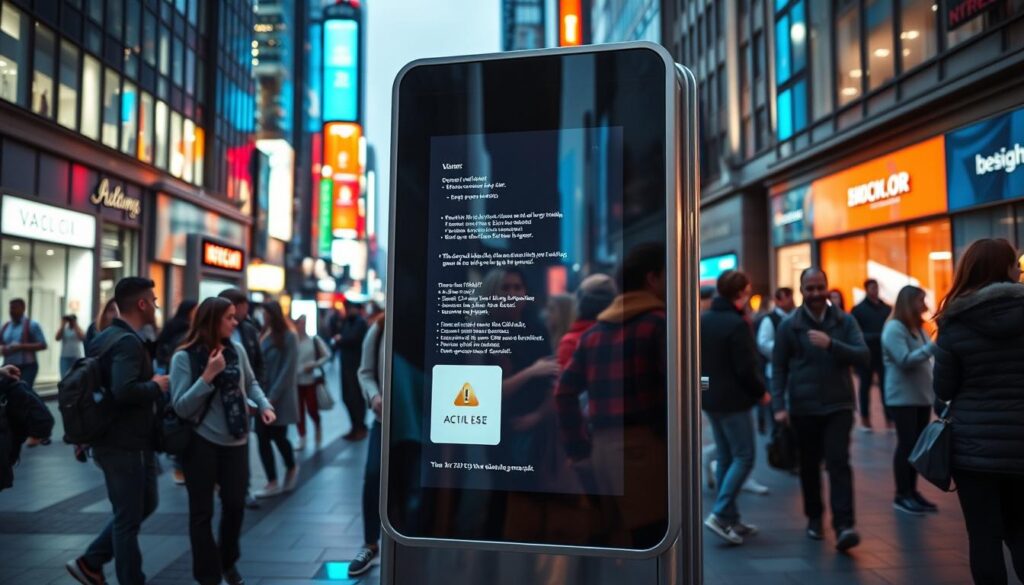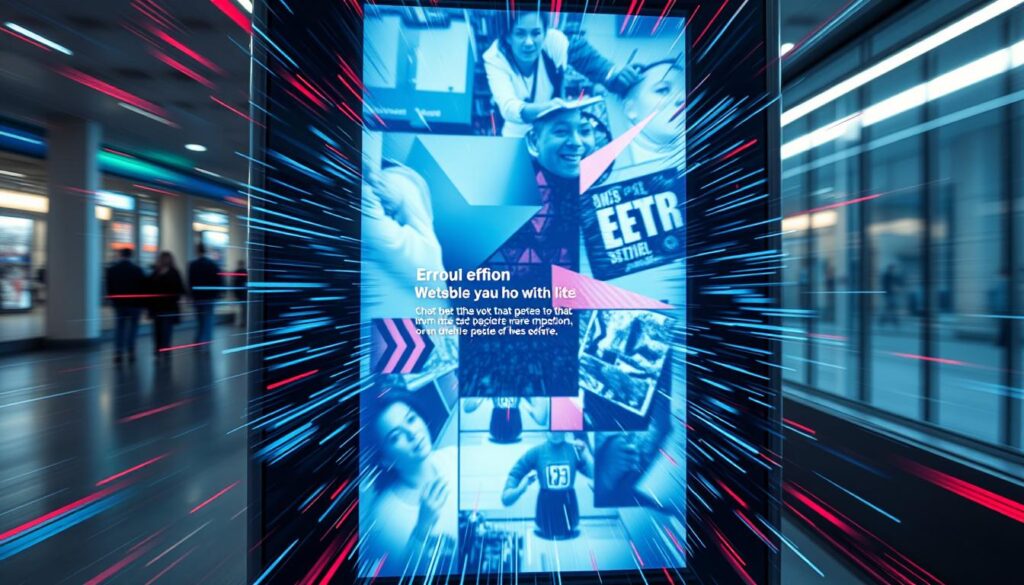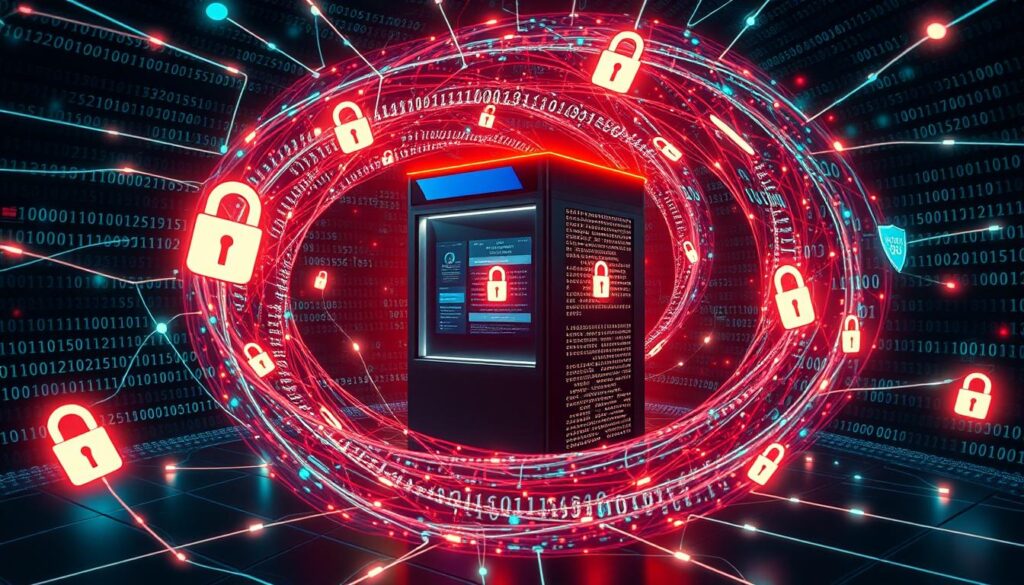Digital kiosks are now common in many fields. They offer easy self-service options for users. These kiosks have touch screens that make it simple to find what you need. But, setting them up, and keeping them running, can be tricky, even more so outdoors.
After a digital kiosk is installed, several problems might pop up. These include issues with where it’s placed, how it handles the weather, and the risk of damage. There could also be problems with how well it shows information, managing what’s on it, keeping it safe, and keeping it working right.
Ignoring these issues can make users unhappy. It can also make things run less smoothly and even put data at risk. This can hurt the good things digital kiosks can do.

Key Takeaways
- Digital kiosks offer convenient self-service solutions, but their installation requires careful planning to address possible issues.
- Challenges can arise in terms of location, weather protection, kiosk damage, display visibility, content management, security, and maintenance.
- Neglecting these factors can result in user frustration, operational inefficiencies, and security breaches, undermining the benefits of digital kiosks.
- Thorough pre-installation considerations and proactive management are key for ensuring the successful deployment and long-term performance of digital kiosks.
- Businesses must prioritize user accessibility, security, and ongoing maintenance to maximize the value of their digital kiosk investments.
Understanding Digital Kiosk Installation Challenges
Digital kiosks are everywhere, helping with tasks like finding your way, buying tickets, and sharing info. They’re great, but setting them up can be tough. Businesses need to tackle these challenges to make sure they work well.
Different Types of Kiosk Applications
- Retail kiosks make shopping easier by letting you check out yourself and cutting down lines.
- Healthcare kiosks help patients check in faster, saving time and work for staff.
- Hospitality kiosks give guests quick access to hotel info, making their stay better.
- Banking and finance kiosks offer automated services and help with customer needs.
- Transportation kiosks sell tickets, show routes, and let you check in at airports.
Pre-Installation Considerations
Before setting up a digital kiosk, think about what it will do, do a site survey, and check the ground, internet, and power. These steps are key to making sure the kiosk works right and lasts a long time.
Location and Environment Factors
Where you put a digital kiosk matters a lot. You have to think about size, weight, light, and how it might block the way. Outdoor kiosks face extra issues like bad weather, damage, and safety. You might also need a permit to put one outside.
“Customized kiosk solutions are found to significantly improve system efficiency compared to ready-made solutions.”
By tackling these setup challenges, businesses can make sure their digital kiosks work well. This means a better experience for users and helps the business run smoother.
Hardware Malfunctions and Physical Damage Risks
Digital kiosks face many hardware problems. These include screen and touch issues, component failures, and damage from the weather. These issues can make the kiosks less reliable, causing frustration for users and problems for businesses.
Screen and Touch Interface Issues
The touchscreen is key to digital kiosks. Keeping it working well is vital. Heat can shorten the life of screens, so good cooling systems are needed.
Outdoor kiosks must be protected from water and dirt. They need IP65 rating to stay weather-resistant.
Component Failures and Breakdowns
Digital kiosks have many parts that can fail. Problems with card readers, cash dispensers, and printers can upset users. Keeping the kiosks in good shape is important.
Weather-Related Damage Concerns
Outdoor kiosks deal with harsh weather. They face extreme temperatures, moisture, and pollution. They are also at risk of vandalism and accidental damage.
They need strong materials and anti-vandalism systems. They should be placed in safe, well-lit spots.
To fix these problems, regular upkeep and good environmental control are key. Using durable, weather-proof materials helps keep digital kiosks working well for a long time.
Software Glitches and User Experience Issues
Digital kiosks make self-service easy, but software problems can mess things up. Issues like freezing, endless loops, display errors, and keyboard problems are common. Also, bad kiosk mode setup can upset users and pose security risks.
It’s key to give clear instructions to users. Making sure everyone can use the kiosk, including those with disabilities, is important. Testing the kiosk well before it goes live helps find and fix any problems.
Keeping the software up to date is a must for smooth operation and safety. Skipping updates can make the kiosk less reliable, leading to more downtime and unhappy customers. Keeping the software current helps avoid software glitches and keeps the user experience good.
| Kiosk Issue | Symptom | Potential Cause | Recommended Solution |
|---|---|---|---|
| Touchscreen Malfunction | Inaccurate touch registration, unresponsive screen | Software glitches, hardware issues | Recalibrate touchscreen, update kiosk mode configuration, replace touchscreen component |
| User Interface Glitches | Random zooming, UI elements not aligning properly | Software glitches, display driver issues | Adjust display settings, update content management software, replace display hardware |
| Peripheral Connectivity Issues | Printer not functioning, inability to detect peripherals | Software glitches, hardware compatibility problems | Check cable connections, update drivers, ensure compatible peripherals |
Fixing software glitches and improving the user experience boosts customer happiness and business success. It makes kiosks work better and more efficiently.

Security Vulnerabilities and Data Protection Issues
Digital kiosks face many security challenges. These include cyber threats and data breaches that risk user information. Physical security issues like theft and vandalism can also affect their operation.
Cybersecurity Threats and Breaches
Recent studies have found weaknesses in visitor management systems. IBM’s X-Force Red team found bugs in five systems, including Lobby Track Desktop and The Receptionist. These bugs could leak personal info and let unauthorized users in.
This shows how vital strong security is. It’s key to keep software up to date and check visitor IDs. This helps prevent digital attacks.
Physical Security Risks
Digital kiosks are also at risk from theft and vandalism. These issues can stop kiosks from working and harm the data they hold. To protect against these, using alarms, remote monitoring, and securing hardware is important.
User Data Privacy Concerns
Digital kiosks collect a lot of data, like visitor info and personal preferences. It’s essential to protect this data with encryption and access controls. Following laws like GDPR and HIPAA is also important.
By tackling these security and privacy issues, digital kiosk providers can make their systems safer. Regular security checks, updates, and protecting user data are key steps. This ensures a secure experience for everyone using digital kiosks.

Maintenance and Technical Support Challenges
Keeping digital kiosks running smoothly is a big job. It involves finding reliable repair services and managing software updates. Getting parts for older kiosks can be hard because manufacturers often stop making them.
Being able to manage kiosks from a distance is key. This lets you keep an eye on many kiosks in different places. Regular cleaning, hardware checks, and software updates are part of a good maintenance plan. They help keep kiosks working well and reduce downtime.
Working with a kiosk management company can help a lot. They offer 24/7 support and can fix problems fast. This means less trouble for customers.
| Kiosk Maintenance and Support Challenges | Solutions |
|---|---|
| Sourcing replacement parts for older kiosk models | Maintain a inventory of common replacement parts or partner with a specialized supplier |
| Managing software updates and patches | Implement a remote management system to automate updates and monitor kiosk performance |
| Responding to hardware malfunctions and physical damage | Establish a 24/7 technical support hotline and emergency repair service |
| Preventative maintenance and regular cleaning | Create a standardized maintenance schedule and train staff on proper kiosk care |
By tackling these kiosk maintenance, technical support, and remote management issues, businesses can keep their kiosks running smoothly. This ensures they are reliable, easy to use, and match the company’s image.
“Downtime due to maintenance can significantly impact the return on investment for self-service kiosks. Investing in commercial-grade materials and a thorough support plan is essential for keeping kiosks up and running. This delivers a smooth experience for customers.”
Conclusion
Digital kiosks bring many benefits to businesses and customers in different fields. But, they also come with challenges like hardware problems, software bugs, and security risks. By understanding these risks, companies can find ways to overcome them and get the most out of their kiosks.
Planning ahead, keeping kiosks in good shape, and working with experts in kiosk management can make a big difference. This approach ensures a smooth, safe, and easy experience for users. Adding features like mobile payments, AI support, and accessibility options can also improve the customer experience and build loyalty.
The use of digital kiosks is becoming more popular because people want convenience, efficiency, and personalized service. Businesses that focus on managing their kiosks well will benefit a lot. They will enjoy the digital kiosk benefits, manage risks effectively, and use the help of kiosk management solutions providers.
FAQ
What are the common issues that can arise after installing a digital kiosk?
Common problems with digital kiosks include software bugs and hardware failures. Security issues, usability problems, and maintenance challenges are also common. Weather, vandalism, power outages, and data privacy concerns can also affect their operation.
What pre-installation considerations are important for digital kiosks?
Before installing a digital kiosk, consider its purpose and conduct site surveys. Check ground stability, internet, and power access. Location factors like size, weight, and light pollution are important, too.
What are the common hardware issues that can affect digital kiosks?
Hardware problems include screen issues, component failures, and weather damage. Overheating can shorten display life. Outdoor kiosks need IP65 protection and face vandalism risks.
What software-related problems can impact digital kiosk functionality?
Software issues like freezing and display errors can harm user experience. Poor configuration can cause frustration and security risks. Regular updates and testing are key to performance and security.
What are the security risks associated with digital kiosks?
Digital kiosks face physical and cybersecurity threats. Weak security can lead to data breaches. Strong passwords, automatic logouts, and updates are essential. Physical risks like theft can be managed with alarms and remote monitoring.
What maintenance and technical support challenges come with digital kiosks?
Maintenance and support are vital for digital kiosks. Finding repair services and managing updates can be tough. Remote management helps with monitoring and maintenance. Regular cleaning, hardware checks, and software updates are necessary.